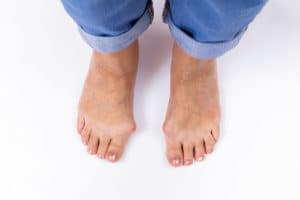There are many common misconceptions about bunions. Bunions are a very common toe deformity, especially for women. However, despite popular opinion, tight shoes are not the main cause. Many people think they are caused by women’s shoes like pumps, stilettos, or other high-heeled footwear, but this is not the case.
You should also know that bunions do not resolve with time. Once a joint becomes deformed, odds are, the deformity will continue to grow. Bunions are progressive, which means they can become worse over time and cannot be reversed without surgery.
If you have one, it is important to come in and see Dr. Miyazaki to have your bunion evaluated, treated, and learn about preventative measures to keep it from worsening. That way, you can improve your big toe’s alignment, curb the pain, and walk with ease. Here is a quick guide to bunions to help you understand them better.
What are Bunions?
Bunions occur when the big toe leans in toward the other toes, and a bony protrusion or a “bump” forms on the joint at the base of the big toe. This bump forms at the metatarsophalangeal (MTP) joint. This joint is very important for helping your foot to push off the ground when you walk. Excessive pressure on the MTP joint can lead to instability in the joint, which then allows the big to start angling inward toward the smaller toes. Over time, continued pressure forces the joint (and the tissue around it) to swell and stick out to the side.
You can form a bunion on the other side of your foot as there is a related condition known as a bunionette or “tailor’s bunion” that occurs when the MTP joint for your small or “pinky” toe is the one that becomes unstable. Much like with a traditional bunion, the MTP joint is forced out, while the little toe starts to point inward towards your other toes. Bunionettes can develop over time as the foot widens as you become older.
What are the Symptoms of Bunions?
The most easily identifiable symptom of a bunion is the unusual, bulging bump found next to the base of the big toe (or the small toe, in the case of a bunionette). Pain that is either constant or intermittent (comes and goes) can be experienced with the condition. In many instances, restricted movement of the affected toe is a problem as well.
Other symptoms that often accompany bunions are:
- Redness
- Swelling
- Big toe pain
- Limitation in walking
- Calluses and corns commonly develop as a result of the bunion
- Soreness
- Problems wearing normal shoes
- Hammertoes can also develop due to the toes being bunched together
The symptoms will vary based on the severity of the problem, which depends on the angle of the protrusion. It can be mild (15 to 30 degrees), moderate (30 to 40 degrees), or severe (40 degrees or over). In severe or moderate cases, the big toe pain is much more prominent, which usually will hinder your daily activities causing severe pain even with just standing and walking.
What Causes Bunions?

The truth is that several factors can influence your risk of getting bunions. It could be a genetic predisposition, meaning that if your parents or grandparents have developed bunions, you have a higher chance of developing one or more yourself.
Although tight-fitted shoes are not the primary cause, they could contribute to the development of this foot deformity or aggravate the symptoms – particularly in shoes with pointed toes or high heels.
Those who are more prone to developing a bunion are patients with short calf muscles, weak connective tissue, joint disease (i.e., rheumatoid arthritis), or a short Achilles tendon. Bunions could also form due to having flatfoot or splayfoot.
What are the Treatment Options for Bunions?
Non-Surgical Treatments
At our podiatry office, we can use conservative treatment to ease the big toe pain and other symptoms. However, due to its progressive nature, the only way to completely correct a bunion is through surgical intervention.
Non-surgical treatment options can address symptoms and possibly slow or prevent bunions from getting worse. The conservative treatments we utilize are using custom orthotics, painkillers, making changes in shoes to get well-fitting shoes, and physical therapy for stretching and strengthening foot muscles.
Surgical Treatment
We will first attempt to relieve any pain or discomfort through those nonsurgical options, but we may recommend surgery, especially if the bunion causes you a lot of pain and impairs your ability to move your toe naturally.
Bunion surgery procedures can be used to realign bones in the toe and foot, remove swollen tissue, and fuse (connect) bones in the affected joint to prevent the bunion from developing again in the future.
Together, we can discuss bunion surgery and determine if it is the right option for you.
Contact Us for Treatment and Help!
If you have developed a bunion or bunionette, come to our Berkeley, CA office for the professional treatment you need. Contact us by calling (510) 647-3744 or by filling out our easy online contact form. We will be happy to answer any questions and assist you in scheduling an appointment with Dr. Miyazaki.
Do not put off getting your bunion evaluated. The earlier that a bunion is treated, the easier the treatment usually is. We will help you every step of the way through your bunion treatment and can answer your questions. Stop letting bunion pain affect you every day!
